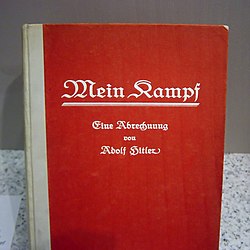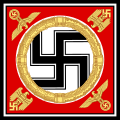
| ||
|---|---|---|
Personal Crimes against humanity Electoral campaigns Legacy  | ||
This bibliography of Adolf Hitler is a thematic list of some non-fiction texts in English written about and by him.
Contents
- Written by Adolf Hitler
- Co-written by Hitler or containing words by Hitler
- Hitler's speeches
- Biographies of Hitler
- Illustrations of Hitler
- Medical studies of Hitler
- Directly related to Hitler
- Indirectly related to Hitler
- Memoirs of people who knew or worked for Hitler
- Articles
- See also
- References
- External links
Thousands of books and other texts have been written about him, so this is far from an all-inclusive list: Writing in 2006, Ben Novak, an historian who specializes in Hitler studies, estimated that in 1975 there were more than 50,000 books and scholarly articles while these numbers rose to 120,000 in 1995, amounting to some 24 books and articles every day, adding that the "number is growing exponentially." [1]
